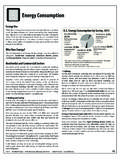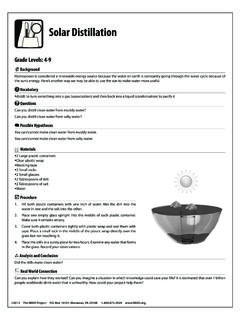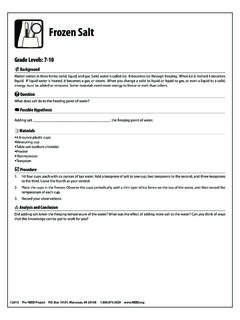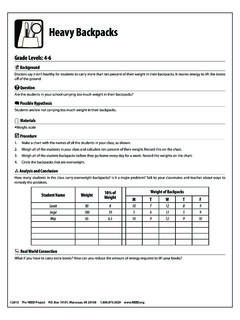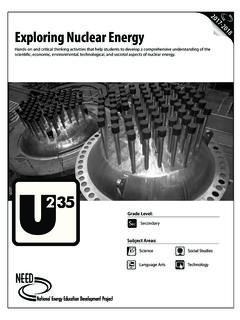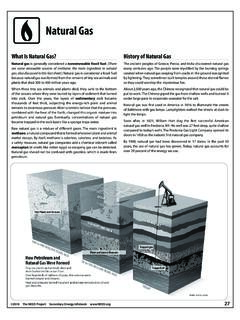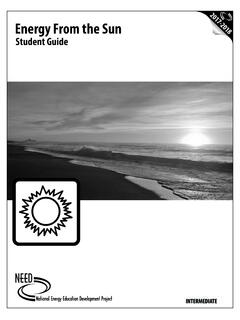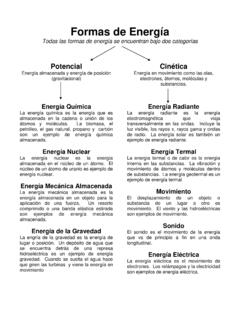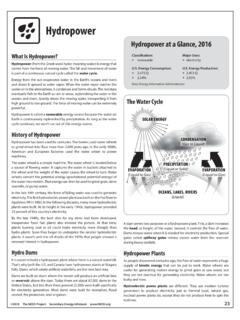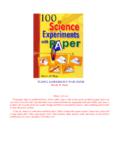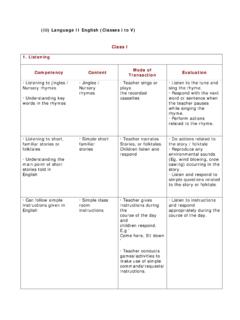Transcription of Saving Energy at Home and School - The NEED Project
1 Saving Energy at home and SchoolTeacher GuideOFFS ciencePriEleIntSecSubject Areas:Language ArtsIntermediateSocial StudiesPriEleIntSecSecondaryGrade Levels:ElementaryTechnologyMathStudents explore Energy sources, efficiency, and conservation with hands-on activities for the classroom and home environments. Each student receives a home Energy Efficiency Kit that corresponds with the classroom lessons, and allows students to share what they have learned with their Saving Energy at home and School Teacher GuidePrinted on Recycled paper NEED Mission StatementThe mission of The NEED Project is to promote an Energy conscious and educated society by creating effective networks of students, educators, business, government and community leaders to design and deliver objective, multi-sided Energy education to CopyNEED curriculum is available for reproduction by classroom teachers only.
2 NEED curriculum may only be reproduced for use outside the classroom setting when express written permission is obtained in advance from The NEED Project . Permission for use can be obtained by contacting Advisory Board In support of NEED, the national Teacher Advisory Board (TAB) is dedicated to developing and promoting standards-based Energy curriculum and Data Used in NEED MaterialsNEED believes in providing teachers and students with the most recently reported, available, and accurate Energy data. Most statistics and data contained within this guide are derived from the Energy Information Administration. Data is compiled and updated annually where available. Where annual updates are not available, the most current, complete data year available at the time of updates is accessed and printed in NEED materials.
3 To further research Energy data, visit the EIA website at 2016 Teacher Advisory BoardShelly BaumannRockford, MIConstance Beatt yKankakee, ILAmy Constant - SchottRaleigh, NCJames M. BrownSaratoga Springs, NYNina Corle yGalveston, TXRegina DonourWhitesburg, KYLinda FonnerNew Mar tinsville, WVSamantha Forbes Vienna, VAMichelle GarlickBob HodashDaNel HoganTucson, AZ Greg HolmanPar adise, CAMatthew InmanSpokane, WABarbara LazarAlbuquerque, NMRobert LazarAlbuquerque, NMLeslie LivelyPorters Falls, WVJennifer Mitchell - Winterbottom Pottstown, PAMollie MukhamedovPort St. Lucie, FLDon Pruett , WAJoanne SpazianoCranston, RITom SpencerChesapeake, VAJennifer Trochez MacLeanLos Angeles, CA Wayne YonkelowitzFayetteville, WVJen VarrellaFort Collins, CO Robert GriegolietNaperville, ILErin GockelFarmington, NYLong Grove, IL 2016 The NEED Project 8408 Kao Circle, Manassas, VA 20110 3 Table of Contents Standards Correlation Information 4 Message to the Teacher 5 Unit Timeline and Overview 6 Materials 7 Lesson 1: Setting the Stage What is Energy ?
4 8 Lesson 2: Using Energy at School 18 Lesson 3: Using Energy at home 24 Lesson 4: Measuring the Energy We Use 26 Lesson 5: Insulation and Weatherization 31 Lesson 6: Heating and Cooling 34 Lesson 7: Water Heating 38 Lesson 8: Windows 43 Lesson 9: Lighting 44 Lesson 10: Appliances and Machines 51 Lesson 11: What We Have Learned 57 Internet Resources 58 Evaluation Form 59 Saving Energy at home and School Teacher GuideOFF 1 Incandescent bulb 1 Compact fluorescent light bulb (CFL) 1 Light emitting diode bulb (LED) 1 Kill A Watt monitor 10 Radiation cans (5 sets of 2) 10 Lab thermometers 5 Sets of insulation materials 3 Student thermometers 1 Indoor/outdoor thermometer 1 Light meter 1 9-volt Battery (for light meter) 1 Flicker Checker 1 Waterproof digital thermometer 1 Digital humidity/temperature pen Flow meter bag Hot water gauge Low flow showerhead Bathroom sink aerator Kitchen sink aerator Roll of teflon tape Outlet and switch plate gaskets Thermostat temperature guide Refrigerator thermometer 1 Light emitting diode bulb (LED)
5 Nightlight Reply form Saving Energy Classroom Kit Student and Family home Energy Efficiency Kit4 Saving Energy at home and School Teacher GuideStandards Correlation Generation Science Standards This guide effectively supports many Next Generation Science Standards. This material can satisfy performance expectations, science and engineering practices, disciplinary core ideas, and cross cutting concepts within your required curriculum. For more details on these correlations, please visit NEED s curriculum correlations website. Common Core State Standards This guide has been correlated to the Common Core State Standards in both language arts and mathematics. These correlations are broken down by grade level and guide title, and can be downloaded as a spreadsheet from the NEED curriculum correlations website.
6 Individual State Science Standards This guide has been correlated to each state s individual science standards. These correlations are broken down by grade level and guide title, and can be downloaded as a spreadsheet from the NEED website. 2016 The NEED Project 8408 Kao Circle, Manassas, VA 20110 5 Dear Educator:This Saving Energy at home and School program provides Energy -related classroom materials that are correlated to the national and state standards and to local level guidelines. NEED s materials and programs have been reviewed by teachers for effectiveness, and are currently in use in schools across the country. The NEED curriculum assists teachers in meeting their Energy standards and assists families and schools in efforts to reduce Energy consumption.
7 The home Energy Efficiency Kits that accompany this guide help students take the lessons they are learning in the classroom to their homes. The kits include items designed to help reduce electricity and natural gas use at home and give students and their families a chance to see how even small measures can make a substantial difference in reducing Energy use. In the classroom, you and your students together will use the Saving Energy Classroom Kit, and students and their families can apply classroom lessons with the home Energy Efficiency Kit. Students will learn about heating and cooling, lighting, electricity, natural gas, and much more. They will learn about ways to make simple changes that can save valuable natural resources and money on their utility bills.
8 The worksheets in this Teacher Guide allow you to assess student activities and to provide us with data to compile regarding overall Energy conservation behaviors. Encourage your students to complete and return the reply card in their home Energy Efficiency guide also references the Department of Energy guide to Energy savings , Energy Saver. This booklet is free for download and makes a great student/family reader supplement to the Student and Family Guide. Encourage students and families to download and read together. (See page 6 for more information.) We are pleased you have chosen to participate in this exciting opportunity and encourage you to contact NEED with any questions you may have. OFFM essage to the TeacherThe NEED Project8408 Kao CircleManassas, VA Saving Energy at home and School Teacher GuideThree Weeks Before Start of Unit Determine the number of students who will participate.
9 If you need additional materials, call NEED at Weeks Before Start of Unit Familiarize yourself with the guides and the materials in the kits. See the materials needed on page 7 and the kit components list on page 3 for more information. Practice the experiments and investigations. During Unit Administer the Pre-Assessment from the Student and Family Guide. Collect student work as directed in the Teacher Additional SupportThe Energy Saver guide, produced and distributed by the Department of Energy (DOE) Office of Energy Efficiency and Renewable Energy , makes an excellent supplement to the student activities and home applications. This guide is available for free download in PDF, MOBI, and EPUB formats and is updated frequently by the DOE. You may download a current copy of this guide by visiting Share the link with students and parents for reading at home in conjuction with home activities, or read the appropriate sections as a class.
10 It may be helpful to Project the guide pages used for each lesson or home of Unit Collect student work as directed in the Teacher Guide. Administer the Post-Assessment from the Student and Family Guide. Return these with the Pre-Assessment to NEED to show us what your students have learned! Complete the unit Evaluation Form on page 59 as a class and return it to NEED. Allow students to take Student and Family Guides home after collecting any student work needed for assessment purposes. Encourage students families to return the Reply Form in their home Energy Efficiency Answer Key1. b 2. c 3. a 4. c 5. b 6. c 7. a 8. b 9. c 10. b 11. c 12. a 13. a 14. a 15. aOFFUnit Timeline and Overview 2016 The NEED Project 8408 Kao Circle, Manassas, VA 20110 7 Saving Energy at home and School MaterialsACTIVITYMATERIALS INCLUDEDADDITIONAL MATERIALS NEEDEDU sing Energy at School Notebook paper Overhead or digital projector Pencils/markers Chart paperInsulation and Weatherization 10 Radiation cans (5 sets of 2) 10 Lab thermometers Insulating materials Masking tape Hot water Rubber bands Timer or stopwatch PitcherHeating and Cooling Digital thermometer Digital humidity/temperature penWater Heating Flow meter bag* Hot water gauge* Digital thermometerWindows Pencils Tape Tissue paperLighting Light meter (with battery)
